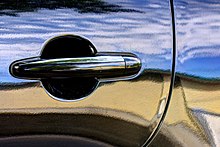As promised last week; here it is with the clear coat on.
The wing design is not complete yet. They put the wings on the fuselage and then taped for the placement of the final design element.
This morning I checked the paint booth and a wing was taped, wrapped and being prepared. By this afternoon, it should be finished-the paint process that is.
Did you notice the heater in the paint booth? Temperature is a consideration for a successful paint process. In the back corner, of the above picture, is an exhaust fan that is blocked shut-and that is literally blocked. Point being that when the fan is turned on the air goes out, so what is the heater warming? The answer is the surface of the wing.
The surface being painted and the air temperature needs to be close to the same temperature for optimal product flow. The wing got chilly last night and is warming slower, than the surrounding air. Thus, the wing is almost done to a room temperature.
A paint process is interesting and challenging because of the variables to be consider for optimal results. I mentioned one, which is temperature, but speed of application, exhaustion of air from the space, low air pressure, incorrect nozzles, spraying at an angle less than perpendicular, or applying excessive paint are some other variables.
Temperature:
Let's consider temperature for a moment. We have found for this area (Tucson vicinity) temperatures between 65 - 100 degrees Fahrenheit work best. Today it may reach 80, but last night it was in the 40s. That wing was chilly last night, but warming right up now via the heater in the paint booth.
Another temperature adaption is in the Boss's paint supplies: four different reducers used with pigment color, and three or four different hardeners used with clear coat depending on the temperature. Temperature adaption is about the flow of the product.
Application:
Another variation in the process is the skill in the actual application or spraying the product onto a surface.
Pneumatic air gun or air brush is used for product application. The rule for application of the product is 8x8, meaning 8 inches from the surface and 8 inch wide spray pattern.
As you probably can imagine, skill is challenged when the surface is curved verses a flat surface-can't find many flat surfaces on an airplane- therefore 8 inches from the surface cannot be perfectly maintained consistently.
Application of pigment color and clear coat differ:
- Pigment color is sprayed onto a surface until a consistency of color is reached.
- Clear coat is sprayed onto a surface "full wet" and slow.
Sounds easy, except when determining what "slow" means. Listed below are the results that may occur when applying clear coat in respect to flow and slow:
- Full wet on and the flow is too much = runs in the clear coat (like overlapping of water)
- Full wet on and the flow is too little = orange peel texture in the clear coat. (Fast evaporation of thinner causing the clear coat to dry into a bumpy surface-like the outside of an orange, as in the picture below.)

What happens when the texture is not perfect, a buffing can work wonders.
Before Lunch pin stripe ready for pigment color.
After lunch and no orange peel in the clear coat.
I found this disk on the wall of the paint booth and wanted to know why the Boss was clear coating an aluminum disc.
He was testing out the finish for Jack's panel. Jack has chosen to have a brushed, clear coated finish-three or four coats of clear coat. I am excited to see the results!
Here are some pictures of the rest of the store for this week at the build center:

Our snowbird cousin, Steve is changing the Boss's tire. What some will do for some warm air.
Lightning Blogger out












